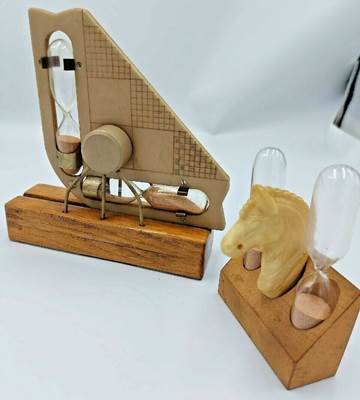Not for Blitz or Bullet
It's the first Sunday of a new month and that means another episode of Top eBay Chess Items by Price (March 2010). As usual, I started by reviewing eBay's chess items that sold in the previous month -- April 2021 for this current post -- in descending order by price.
Chess clocks frequently appear on the initial short list for 'Top eBay Chess Items', but rarely make the final cut. Although important as a chess accessory, there's not much to add about them. The previous post featuring a clock was Double Dutch Clocks (October 2013).
The item pictured below was titled 'Rare vintage hourglass for playing chess in the USSR'. It sold for around 600 US$, 'Best offer accepted'.

The description added,
Vintage clock for playing chess. Additional flasks for quick rearrangement. The vertical clock counts down the time, the horizontal one is stopped. With a slight movement of the recruit, everything is the opposite.
The 'additional flasks' must be the two hourglasses to the left and right of the chess Knight's head. According to another photo showing a ruler, the clock mechanism on the left is 16 cm wide; the reserve holder on the right is 8 cm wide. I can't imagine that the hourglasses hold much sand.
A search for similar clocks led to How do we appreciate time? A history of chess clocks (chess.com). There I learned,
The first major chess [clock?] revolution began in 1852, when a quasi-unknown writer named Andrew Cantab wrote an article in which he argued that each player should have limited time for the entire game. Moreover, he proposed a solution: the introduction of hourglasses with sand. [...] The propaganda was successful, and the hourglass was officially introduced to a tour for the first time in 1861, at the match between Anderssen and Kolisch, in London. The agreed playing time was 24 moves in two hours.
Going back to my post Tabulating the Rabbit Hole (June 2019; 'chart shows periodicals published by country and by year'), there are plenty of potential references from 1861. That might make a compact follow-up project.




No comments:
Post a Comment